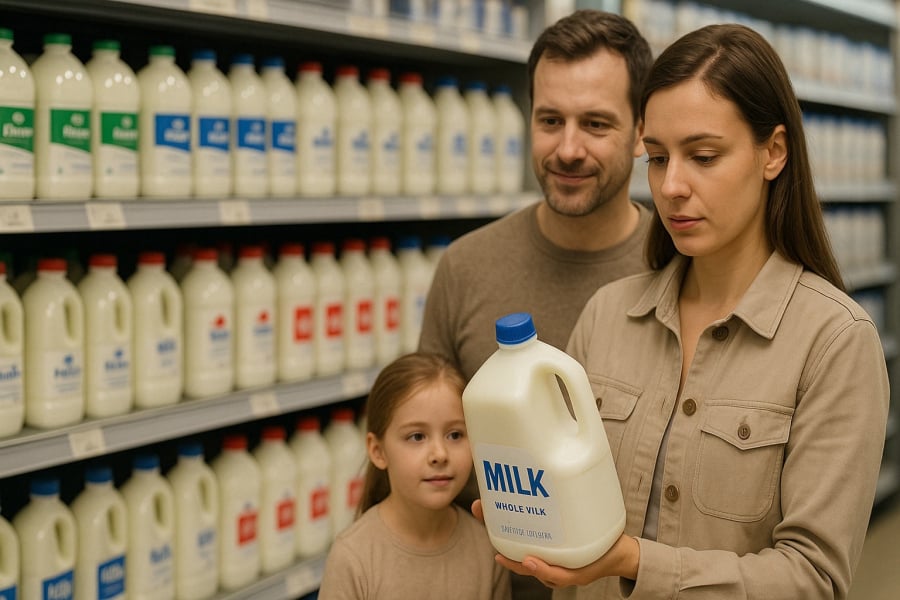In an era of information overload, incidents related to contaminated food, especially fake milk, are no longer strange. Recently, the bust of a fake milk production ring in Hanoi has caused a stir. What is more concerning is that these products mainly target vulnerable groups such as children, pregnant and lactating women, the elderly, or those with a history of underlying conditions such as kidney failure and diabetes. So, how detrimental is fake milk to one’s health? How can we detect and prevent consuming it? Let’s find out in the following article.
Fake Milk – The Silent Killer Lurking in Every Box
According to Dr. Le Thao Nguyen, a nutrition expert at Nam Saigon International Hospital (quoted from Thanh Nien newspaper), fake milk is a product manufactured with substandard processes, containing little to no nutritional value as advertised on its label. Instead, they often consist of harmful additives, heavy metals such as lead and cadmium, or unsafe coloring agents.
Not only does fake milk cause nutrient deficiencies, but prolonged consumption can also have severe repercussions on the liver, kidneys, digestive system, cardiovascular system, and immune system. Especially for children and the elderly, who have weaker immune systems, the consequences of fake milk can be dire.

The Adverse Effects of Fake Milk on Human Health
Burden on the Liver and Kidneys
The liver and kidneys are the primary organs responsible for detoxification in the body. However, when exposed to toxic substances in fake milk, such as heavy metals or melamine, these organs become overwhelmed. Dr. Nguyen warns, “Prolonged consumption of fake milk can lead to toxin buildup, causing severe damage to the liver and kidneys, increasing the risk of conditions like liver and kidney failure and even potentially leading to cancer.”
Severe Impact on the Digestive System
Children and the elderly have sensitive digestive systems. Consuming fake milk with inferior ingredients can cause digestive disorders, manifested by symptoms such as abdominal pain, vomiting, and diarrhea. Moreover, some types of fake milk contain bacteria or toxins from mold, leading to acute poisoning with symptoms such as seizures, high fever, or even coma.
Cardiovascular Risks
Certain fake milk varieties have been found to contain excessive levels of trans fat and sodium. These are known adversaries of cardiovascular health. Long-term consumption can increase bad cholesterol, leading to atherosclerosis, hypertension, and stroke. For individuals with underlying conditions like diabetes or kidney disease, the dangers are even more pronounced.
Immune System Compromise
The immune system, especially in children and those with underlying conditions, relies heavily on essential micronutrients like zinc, selenium, vitamins A and D, and essential fatty acids. However, fake milk often lacks these vital nutrients, making the body susceptible to bacterial and viral infections. Children who consume fake milk are at higher risk of developing pneumonia, otitis media, or influenza. For adults, especially the elderly, a weakened immune system can exacerbate existing health issues.
Risks of Acute and Chronic Poisoning
Acute poisoning from fake milk is often associated with toxins like aflatoxin from mold or melamine. Melamine buildup can lead to kidney stone formation and acute kidney failure. Chronic poisoning occurs with long-term consumption, resulting in the accumulation of toxins like lead. Research shows that lead has severe neurological impacts, potentially causing cognitive impairment in children and memory loss in adults.
How to Distinguish Between Real and Fake Milk
Dr. Le Thao Nguyen recommends some basic methods to identify fake milk:
- Check the barcode: Each country has a unique barcode. For example, Vietnam’s is 893, and the US’s is 000-019 or 030-039. If the barcode doesn’t match the manufacturer or cannot be traced, be cautious.
- Examine color and texture: Genuine milk usually has a light yellow or ivory color with a soft, smooth texture and no lumps. In contrast, fake milk often has abnormal colors like dark yellow or gray and may feel rough, with a lumpy consistency.
- Test aroma and taste: Real milk has a gentle aroma and a natural, subtle sweetness that dissolves slowly in the mouth. Fake milk often has a strong, sharp smell, sometimes with a chemical hint, and may taste unpleasantly sour.
However, according to Dr. Nguyen, these methods are only for reference. As counterfeit milk production techniques become more sophisticated, it is challenging for consumers to detect them by eye. Therefore, it is best to purchase products from large supermarkets, reputable stores, or directly from the manufacturer’s official website.

Expert Advice
To safeguard your and your family’s health, Dr. Le Thao Nguyen emphasizes, “Consumers should be vigilant and not compromise their health by opting for cheap, unknown products. Prioritize reputable brands with clear quality assurance certifications.” She also encourages individuals to enhance their knowledge about clean and safe food through official media channels.
Conclusion
Fake milk is not just a health issue; it is a wake-up call for consumers’ awareness. Prioritize your and your family’s well-being by choosing products with clear origins. Don’t let a lack of knowledge put you and your loved ones at risk from inferior goods. Let’s join hands to protect our community’s health!

































